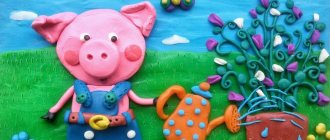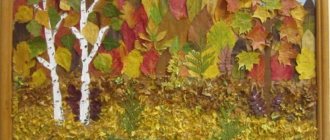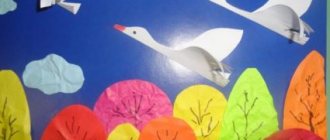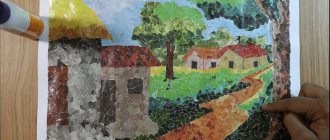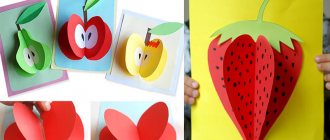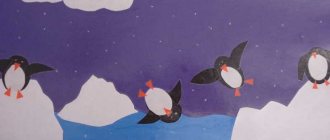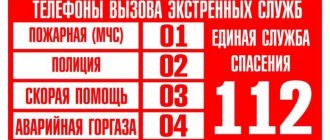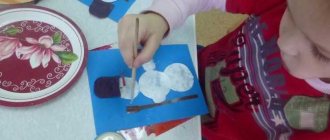Appliquéing a person is a very exciting and creative job. Its advantage is the variety of techniques used and varying complexity. Such work is suitable for very young children, preschoolers and elementary school students. Using the application, you can study geometric shapes, colors, parts of a person’s face, and his emotions.
Application of a man from geometric shapes
Different techniques allow you to captivate children of any age with applique. For the first experiment, an applique of a person made from geometric shapes is good.
This method of execution will help develop the child’s associative thinking, help him understand the shapes of body parts and identify similar shapes.
In the photo of the applique, a full-length person is shown using simple shapes made of colored paper. You can also use blanks made of fabric or thick cardboard.
To ensure that classes with your baby are as educational as possible, adults should use the following techniques:
- Say out loud the names of body parts, show them on the child’s body;
- Say the names of the figures and demonstrate their similarity to parts of the body;
- Help the child understand where this or that part of the body should be in space and place it correctly on paper.
As for practice, for younger aunts you need to prepare templates of geometric shapes, which all you have to do is glue them correctly onto a sheet of paper.
The places for gluing the figures can be marked on paper with an outline to make it easier for the baby to determine how to position the parts of the body relative to each other, or you can leave the baby a chance to determine for himself where the legs and arms of his person will look best.
Older children can be trusted to cut out geometric shapes themselves and place them on paper. As you acquire skills, the task can be complicated by asking your child to make a composition with the image of several people.
Movable little man
Patterns of human body parts can make applique more interesting for children. With their help, it is possible to achieve a realistic, bright picture or give it dynamics. Surely older children will enjoy the dynamic applique.
To work you will need:
- templates of body parts (arms, legs, torso, head);
- screws and nuts from a metal constructor;
- cardboard;
- glue;
- scissors.
The work is carried out in several stages:
- Templates printed on paper are cut out and glued onto thick cardboard. This makes them stronger. Then the parts are cut out of cardboard.
- Place your hands on the body and use sharp scissors to make a through hole. A screw is inserted into it and a nut is tightened. I repeat the operation with my legs.
- The head is attached to the body in a similar way.
The little man gains mobility and is ready to play. To complicate the work, you can create additional connections at the elbows and knees.
Applications are a fascinating creativity that develops imaginative thinking, perseverance, and fine motor skills. Working with paper is suitable for children of all ages. Having mastered the skills of appliqué on paper, you can move on to more interesting and complex activities - for example, creating a reusable game with felt Velcro.
Application of a person's face made of paper
Having seriously studied body parts and geometric shapes, you can distract yourself a little and do more creative things - applique of the human face.
Here the child gets more space for imagination and enjoys studying not only the parts of the face and their names, but also practices using facial expressions to distinguish and show different emotions.
As with other applique techniques, parents need to talk about the face, sensory organs and their functions, show them to the baby on the body and discuss their position relative to each other.
On a sheet of paper, you should mark the outline of the face with a pencil, or prepare a circle or oval from paper, which will become the basis of the face and the rest of the elements will be placed on it.
You should try to prepare several variations of facial elements in advance:
- Different eye colors and sizes;
- Eyebrows of different shapes
- Several nose options;
- Several smiles expressing different emotions;
- Ears of different sizes and shapes;
- Hair: hairstyles for boys and girls;
- Additional accessories (bow, hat, etc.).
In the process of making the applique, it is better to help the child stick the base face onto a sheet of paper and place the eyes correctly on the face - they will become a reference point for the baby, relative to which all other elements of the face need to be positioned.
By gluing eyebrows above the eyes, a nose in the center of the face, ears parallel to the eyes, the child learns the basics of symmetry and proportions. Several stencil options will add an element of play and fun to this process.
A beautiful applique will not only delight your baby, but will also immerse him deeper into the world of creativity.
APPLICATION. “DESIGN A FUNNY ANIMAL”
Software tasks.
Develop imagination and creativity (the ability to independently assemble an animal from circles and semicircles of different sizes and colors); continue to practice children in cutting circles from squares and semicircles by cutting the circles in half along the fold; compose an image from parts in a certain sequence, placing first the large parts in the middle of a sheet of paper, then the small ones.
Material.
The teacher has a decorated box for the didactic game “Funny Animals”, cardboard circles and mosaic semicircles (see lesson 8). Children have sheets of thick paper or cardboard the size of 1/2 a landscape sheet. Squares of three or four sizes for cutting circles and semicircles and ready-made small circles in one box for two children; scissors, glue.
Progress of the lesson.
Remind the children that they made various funny animals from a mosaic. To say that today everyone will come up with a little animal and compose it on a piece of paper from circles and semicircles. Children will cut out large circles and semicircles from squares, and keep small circles in a box. If they need small half circles, you can cut the small circles in half.
In conclusion, say: “Then we will make a board game “Funny Animals” from your applications and play it. I have already prepared a box for cards with animals. Here she is".
During the lesson, remind, if necessary, how to cut circles from squares. Ask some children what kind of animal they are going to depict, from which figures they will make this or that part of the body. Encourage those who decide to depict an animal in motion (sitting, running, etc.). Make sure that the children first lay out the large parts of the animal (torso, head), and do not rush to stick them on right away until they select the most suitable shapes and sizes for certain parts of the body. You can invite individual children to replace some figures with others and see if it works better. We should approve of those children who add interesting details to their images and decorate them with small details.
At the end of the lesson, put children's applications on the stand and examine them. When pointing to a particular work, ask what kind of animal is depicted on it. If identical animals are named, draw the attention of all children to their differences, emphasizing that the children portrayed the same character in their own way. Mark original works with characters that children had not previously created while playing with mosaics.
If time permits, conduct several play exercises with children's appliqué:
1. Place one of the cards in front of the children and offer to pick up cardboard figures - circles and semicircles of the same size and the same amount as it took to draw the animal on the card. The color of the figures is not taken into account.
2. Place another card in front of the children and ask them to count how many circles and how many semicircles went into the image of the animal, and determine which figures were used more.
3. Find figures of the same color as those used in the image of the animal. If the color was repeated in several parts of the animal, then it is enough to select one circle of this color.
Note. Game exercises should be carried out with children in their free time, giving each a card with an image of an animal. You can select other game actions.
LESSON 10
APPLICATION. “FUNNY PEOPLE FROM CLUBS”
Software tasks.
Continue to develop children’s imagination and creativity, the ability to independently invent human figures from circles and semicircles; convey simple movements of the arms or legs of the figures; make human figures starting from the head.
Material.
The teacher has 3-5 samples with images of different people made from circles and semicircles. Children have several squares: 7.5x7.5 cm;
6 × 6
cm
and 4 × 4
cm
and ready-made small circles (see mosaic figures made from material for the lesson in different colors, including squares and ready-made figures in pink or light orange to depict a face and palms; sheets of thick paper 1/2 in size 2 album sheets; scissors, glue.
in different colors, including squares and ready-made figures in pink or light orange to depict a face and palms; sheets of thick paper 1/2 in size 2 album sheets; scissors, glue.
Progress of the lesson.
The teacher addresses the children:
— In the last lesson, you yourself came up with and depicted various funny animals from circles and semicircles. What do you think, children, is it possible to use circles and semicircles to depict something other than animals?
- So I decided to make little men out of circles and semicircles. Look what funny little men I came up with. (Shows 3-5 images.) Are these people different or the same? Why did they turn out different, since they are all made up of circles and semicircles? Yes, all parts of the human body are made up of circles and semicircles of different sizes, colors and numbers. One man’s body is made up of two or three small circles, another’s is made up of one large circle, the third’s is made up of a circle and a semicircle. (You can also compare their heads, legs, arms, costume details and movements.)
— All these little men are made up of circles and semicircles of different colors. And who will notice which parts of the body all the little men have the same color? (Pink face and pink palms.) These little men want you to invent and portray friends and girlfriends for them, but only so that each new little man is different from the others. They will not accept the same people into their company.
The teacher removes the samples and invites the children to start working.
If necessary, reminds the children that they will cut out large circles and semicircles themselves from squares, and they have small figures ready in boxes.
During the lesson, the teacher makes sure that the children first make a figure of a man, and then stick it on, starting from the head. It suggests that the head should be glued a little away from the top edge of the sheet of paper so that hair, a cap, etc. can be depicted on the head.
Encourages to depict various details on the costumes of the little men: collar, pockets, buttons, bows. This will help give the characters expressiveness and variety.
At the end of the lesson, you can put samples on the stand and say: “Little people have come to meet their new friends. But first they want to see if the new kids are different from themselves and from each other.” Invite four or five children to place their images separately from the samples, and everyone to see how the characters differ from each other. Then place them next to the samples.
Carry out the same work with the applications of other children. In conclusion, it is very interesting to look at these little men, because they are all different, and each child came up with and portrayed a funny little man in his own way.
LESSON 11
Application of a man in motion
The next level of complexity is considered to be the appliqué of a person in motion. This application for children will seem more painstaking and will require their concentration.
But, in addition to basic skills, it will allow children to study the structure of the body, the names of poses and directions of movements. The basis of this technique is the application of a person from geometric shapes.
This time you will need to make more smaller pieces:
- The arms and legs are depicted from two thin rectangles;
- The human torso is a square or rectangle;
- The head is a smaller square or circle;
For clarity, you can always offer the child a basis from which he can start and continue to act independently: for example, glue torso figures for two people at once onto a piece of paper, and invite the child to glue his hands so that the figures are in different poses.
Of course, all the names of the poses need to be voiced and shown to the baby by example. As experience accumulates, the child will be able to create compositions from several figures depicting active ball games, physical education lessons, swimming, dancing and many other movements familiar to him.
MAGAZINE Preschooler.RF
Educational field “Artistic creativity” (Lesson type: final)PROGRAM CONTENT: 1. Create conditions for successful motivation of practical activities. 2. Teach children to invent and portray fantastic people. 3. Develop and improve the skills and abilities of constructive and design creativity, using the tearing method. 4. Express the character of the characters in the application with gestures and movements. 5. Develop children's creative activity, independence and initiative. MATERIAL: 1. Toy Bon – Bon (made of cardboard, candy wrappers, candies). 2. Models (take a candy wrapper, fold the candy wrapper crosswise in three, iron the fold and tear it into three parts. From the middle part we get the head and torso. We bend the side parts lengthwise and tear them in half. We bend the resulting parts in half again and also tear them. We got two “arms" and two “legs” that can bend and unbend. We put together a “candy man” from torn pieces). HOD: Guys, what are you in the mood for? Show how cheerful you are (crying is heard behind the doors) Guys, you are all cheerful, but who is crying then? I'll go and have a look (I bring in the Bon-Bon toy) Bon: Hello, guys, my name is Bon-Bon. Educator: What happened to you, why are you crying? Bon: I lost my Caramel Country. Educator: Look, this is not your country? Bon: No, but I like her too, but I’ll be bored alone. Educator: Guys, why will Bon be bored? Do you like to play alone? Why? How can we help Bon-Bon? Only I have nothing (at this time there is noise). What sounds? I don’t know, maybe you know? What could be rustling like that? Oh, look, there’s some beautiful box lying here. Let's open it. That's where the noise was coming from. These are candy wrappers. Do you think candy men look just like people? That's right, like real people, they have all the parts of their body that should be in their place. What parts of the body do you know? How many arms and legs? Can your head tilt and can your arms and legs bend? Move your head, arms, legs. Now let's go to the tables, and put Bon - Bon here, he will watch how you make little men. Look how an ordinary candy wrapper turns into a little man (I show models). Before we start, let's play with our fingers. One, two, three, four, five Let's count fingers Strong, friendly Everyone is so necessary. Now let’s start creating our own caramel man (to instrumental music). Our most delicious caramel country is located on the table, come up and stick your sweet inhabitants. Do you like our caramel country? With what? What mood are your people in? Do you think Bon-Bon will like her? Let's call him. Guys! Look, Bon—Bon smiled. Bon: What a beautiful caramel country. I like her, I'm so happy. Thank you very much. I also want to give you a gift. Here's a sweet caramel for you. Educator: Oh, there are many of us, but there is only one candy. Wait, there's something in it. Let's see (I'll treat you to caramel). Let's dance with caramels (to music). Guys, now you know that you don’t need to throw away candy wrappers, but you can make many, many funny caramel men out of them and play with them. Thank you.
| Next > |
Studying human anatomy using application
Older children can also use appliques to learn body anatomy. The older the child, the more elements of internal organs will be needed. To begin with, it is enough to use blanks to illustrate the brain, lungs, heart, stomach, liver and kidneys.
The more organs the child knows, the more new elements can be added, for example, adding intestines, spleen, etc. to the application.
Since studying anatomy is a lengthy process, appliqué elements are usually made of durable multi-colored materials, such as felt or colored cardboard.
Organ templates can be taken from human anatomy atlases.
Applications for advanced
All creative tasks develop imagination in children and adults, a craving for handicrafts and art. When we learn to make appliqués with our own hands, then, as with any task, we can approach the matter precisely and strictly “as per the manual,” or we can add elements of play and even mischief.
To further involve your child in the process, use other, non-standard materials in addition to paper:
- Thick knitting threads that can be woven into braids are well suited for hair;
- For hairstyles and beards - cotton wool;
- To depict clothes, you can mix different materials: paper and fabric, glitter, paper curls;
If you have mastered paper applique, you can safely move on to other types: appliques made from beads, from seeds, from autumn natural materials.
The main thing is that children and adults enjoy this process.
